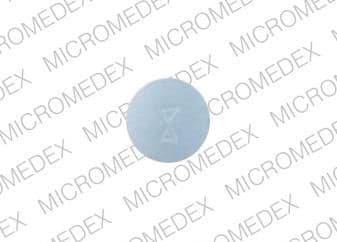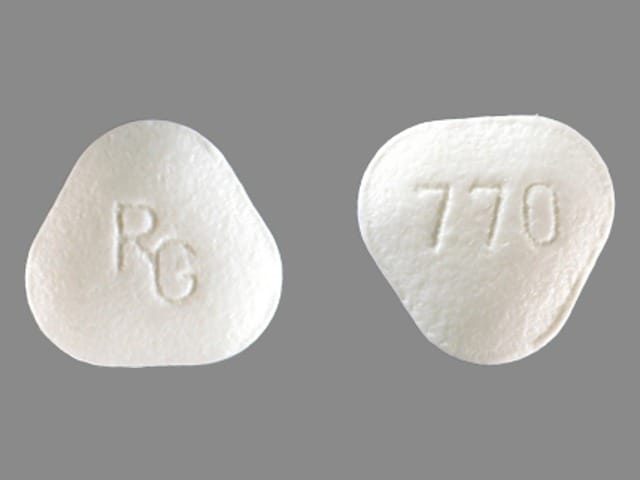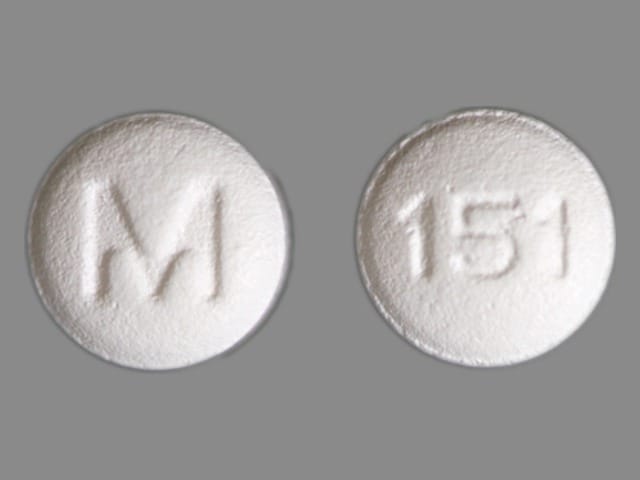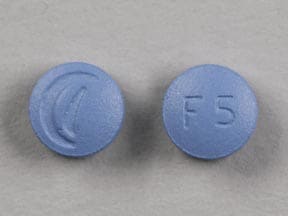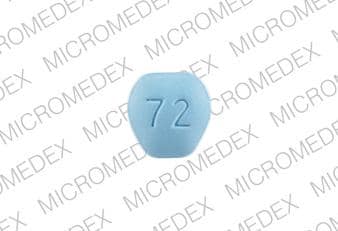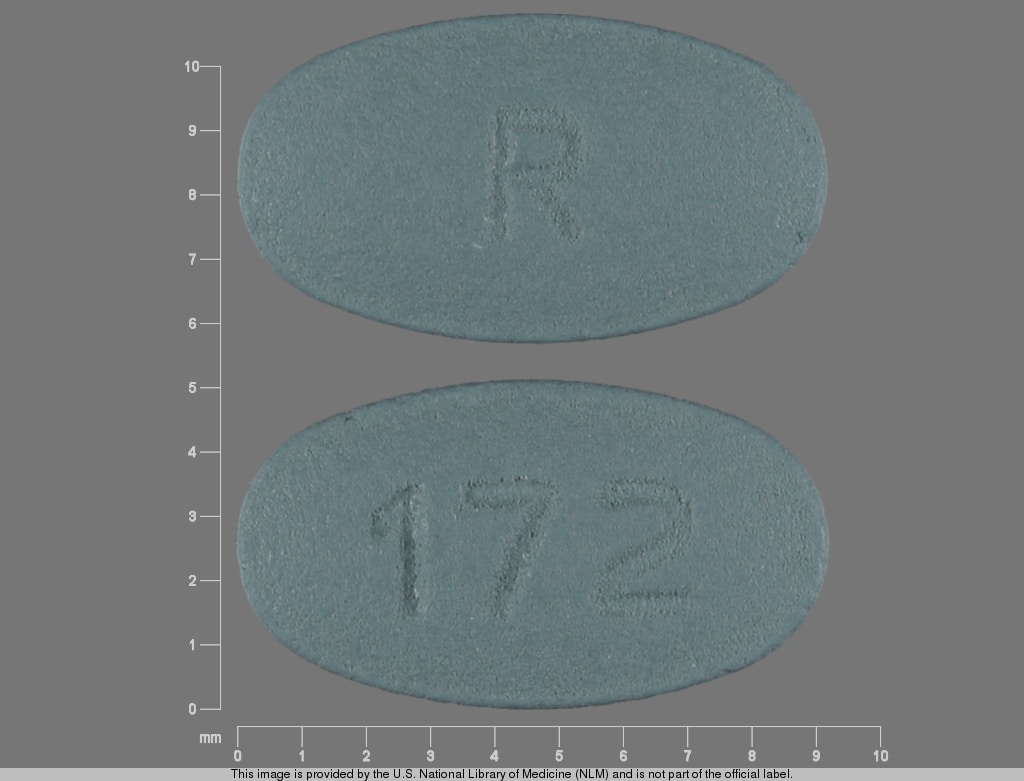Dosage Forms
Excipient information presented when available (limited, particularly for generics); consult specific product labeling.
Tablet, Oral:
Propecia: 1 mg
Proscar: 5 mg [contains fd&c blue #2 aluminum lake]
Generic: 1 mg, 5 mg
Pharmacology
Mechanism of Action
Finasteride competitively inhibits type II 5-alpha reductase, resulting in inhibition of the conversion of testosterone to dihydrotestosterone and markedly suppresses serum dihydrotestosterone levels
Pharmacokinetics/Pharmacodynamics
Distribution
Vdss: 76 L
Metabolism
Hepatic (extensive) via CYP3A4; two active metabolites (<20% activity of finasteride)
Excretion
Feces (57%) and urine (39%; as metabolites)
Time to Peak
Serum: 1 to 2 hours
Duration of Action
Dihydrotestosterone levels return to normal within 14 days of discontinuation of treatment; BPH: Prostate volume returns to baseline within ~3 months after discontinuation; Male pattern baldness: Reversal of increased hair count within 12 months
Half-Life Elimination
5 to 6 hours (range: 3 to 16 hours); Elderly (≥70 years): 8 hours (range: 6 to 15 hours)
Protein Binding
~90%
Use in Specific Populations
Special Populations: Renal Function Impairment
Urinary excretion of metabolites was decreased in patients with renal impairment. This decrease was associated with an increase in fecal excretion of metabolites. Plasma concentrations of metabolites were significantly higher in patients with renal impairment (based on a 60% increase in total radioactivity AUC).
Special Populations: Elderly
Mean AUC0-24 increases 15%.
Use: Labeled Indications
Androgenetic alopecia (male pattern hair loss): Treatment of male pattern hair loss in men.
Limitations of use: Efficacy in bitemporal recession has not been established.
Benign prostatic hyperplasia: Treatment (monotherapy) of symptomatic benign prostatic hyperplasia (BPH) to improve symptoms, reduce the risk of acute urinary retention, and reduce the risk of need for BPH-related surgery; used in combination with an alpha-blocker (doxazosin) to reduce the risk of symptomatic progression.
Limitations of use: Not approved for the prevention of prostate cancer.
Use: Off Label
Hirsutismbyes
Data from a systematic review and network meta-analysis of published randomized trials of women with hirsutism (idiopathic, related to polycystic ovary syndrome or nonclassic congenital adrenal hyperplasia) support the use of finasteride for treatment of hirsutism Barrionuevo 2018.
Based on the
Contraindications
Hypersensitivity to finasteride or any component of the formulation; pregnancy or women of childbearing potential
Dosage and Administration
Dosing: Adult
Androgenetic alopecia (male pattern hair loss): Males: Oral: 1 mg once daily. Continue for at least 12 months to assess full effect; continued daily use is required to sustain benefit (Donovan 2019; Leyden 1999; Whiting 1999).
Benign prostatic hyperplasia (alternative agent): Note: Reserve use for patients with significantly enlarged prostates, those intolerant of or refractory to alpha-1 adrenergic antagonists, or those with hematuria associated with benign prostatic hyperplasia (AUA [McVary 2010]; Cunningham 2019).
Males: Oral: 5 mg once daily (either as a single agent or in combination with an alpha-1 adrenergic antagonist); 6 to 12 months of treatment is usually needed to improve symptoms (AUA [McVary 2010]; Cunningham 2019; McConnell 2003).
Hirsutism (alternative agent) (off-label use): Note: Typically given in addition to oral contraceptives (OCs) if inadequate response to OCs is observed after 6 months. May be considered as initial therapy for females who cannot conceive or who are using reliable contraception.
Females: Oral: 2.5 to 5 mg once daily. Assess response at 6-month intervals before adjusting dose, adding additional agents, or switching to alternative therapy (Barbieri 2019; Endocrine Society [Martin 2018]).
Dosing: Geriatric
Refer to adult dosing.
Administration
May be administered with or without meals. Females of childbearing age should not touch or handle crushed or broken tablets.
Storage
Propecia: Store at 15°C to 30°C (59°F to 86°F). Keep container tightly closed and protect from moisture.
Proscar: Store below 30°C (86°F). Protect from light. Keep container tightly closed.
Finasteride Images
Drug Interactions
There are no known significant interactions.
Test Interactions
PSA levels decrease in treated patients. After 6 months of therapy, PSA levels stabilize to a new baseline that is ~50% of pretreatment values. If following serial PSAs in a patient, re-establish a new baseline after ≥6 months of use.
Adverse Reactions
>10%: Genitourinary: Impotence (monotherapy: 5% to 19%)
1% to 10%:
Cardiovascular: Orthostatic hypotension (monotherapy: 9%), peripheral edema (monotherapy: 1%), hypotension (monotherapy: 1%)
Endocrine & metabolic: Decreased libido (monotherapy: 2% to 10%), gynecomastia (monotherapy: 1% to 2%)
Genitourinary: Ejaculatory disorder (monotherapy: <1% to 7%), decreased ejaculate volume (monotherapy: 2% to 4%), sexual disorder (3%), breast tenderness (monotherapy: ≤1%)
Hematologic & oncologic: Prostate cancer (high grade: 2%)
Respiratory: Rhinitis (monotherapy: 1%)
<1%, postmarketing, and/or case reports: Altered mental status, breast hypertrophy, change in libido, depression, hypersensitivity reaction, male infertility (temporary), malignant neoplasm of the breast (men), suicidal ideation (Welk 2017), suicidal tendencies (Welk 2017), testicular pain
Warnings/Precautions
Disease-related concerns:
- Diminished urinary flow: Carefully monitor patients with a large residual urinary volume or severely diminished urinary flow for obstructive uropathy; these patients may not be candidates for finasteride therapy.
- Hepatic impairment: Use with caution in patients with hepatic impairment; finasteride is extensively metabolized in the liver.
- Prostate cancer: When compared to placebo, 5-alpha-reductase inhibitors (5-ARIs) have been associated with an increase in the incidence of high-grade prostate cancers; 5-ARIs are not approved in the US or Canada for the prevention of prostate cancer.
Special handling:
- Females/pregnancy: Active ingredient of crushed or broken tablets can be absorbed through the skin; unbroken tablets are coated which prevents contact with the active ingredient during normal handling. Pregnant females should avoid contact with crushed or broken tablets; finasteride may negatively impact fetal development.
Other warnings/precautions:
- Appropriate use: Other urological diseases (including prostate cancer) should be ruled out before initiating (in BPH management). Not indicated for use in pediatric patients.
- Duration of therapy: For BPH, a minimum of 6 months of treatment may be necessary to determine whether an individual will respond to finasteride; for male pattern hair loss, daily use for 3 months or longer may be required before benefit is observed (withdrawal of treatment leads to reversal of hair growth effect within 12 months).
- PSA monitoring: Reduces prostate specific antigen (PSA) concentration by ~50% within 6 months of treatment. To interpret serial PSAs, a new PSA baseline should be established ≥6 months after treatment initiation and PSA monitored periodically thereafter. A confirmed PSA increase while on this medication, even if within normal limits, may be associated with an increased risk for prostate cancer and should be evaluated. Finasteride does not interfere with free PSA levels.
Monitoring Parameters
To interpret serial PSAs, establish a new PSA baseline ≥6 months after treatment initiation and monitor PSA periodically thereafter. Objective and subjective signs of relief of benign prostatic hyperplasia, including improvement in urinary flow, reduction in symptoms of urgency, and relief of difficulty in micturition.
Pregnancy
Pregnancy Risk Factor
X
Pregnancy Considerations
Use is contraindicated in females of childbearing potential.
Abnormalities of external male genitalia were reported in animal reproduction studies. Pregnant females are advised to avoid contact with crushed or broken tablets.
Adequate contraception is recommended if used off-label in the management hirsutism in females associated with PCOS (ACOG 194 2018).
Patient Education
What is this drug used for?
- It is used to help hair growth in male pattern baldness. It may take 3 months to see the full effect.
- It is used to treat the signs of an enlarged prostate. It may take a few months to see the full effect.
- It may be given to you for other reasons. Talk with the doctor.
Frequently reported side effects of this drug
- Sexual dysfunction
- Fatigue
- Loss of strength and energy
- Decreased sex drive
Other side effects of this drug: Talk with your doctor right away if you have any of these signs of:
- Enlarged breasts
- Severe dizziness
- Passing out
- Depression
- Testicle pain
- Lump in breast
- Breast soreness or pain
- Nipple discharge
- Signs of a significant reaction like wheezing; chest tightness; fever; itching; bad cough; blue skin color; seizures; or swelling of face, lips, tongue, or throat.
Note: This is not a comprehensive list of all side effects. Talk to your doctor if you have questions.
Consumer Information Use and Disclaimer: This information should not be used to decide whether or not to take this medicine or any other medicine. Only the healthcare provider has the knowledge and training to decide which medicines are right for a specific patient. This information does not endorse any medicine as safe, effective, or approved for treating any patient or health condition. This is only a brief summary of general information about this medicine. It does NOT include all information about the possible uses, directions, warnings, precautions, interactions, adverse effects, or risks that may apply to this medicine. This information is not specific medical advice and does not replace information you receive from the healthcare provider. You must talk with the healthcare provider for complete information about the risks and benefits of using this medicine.
